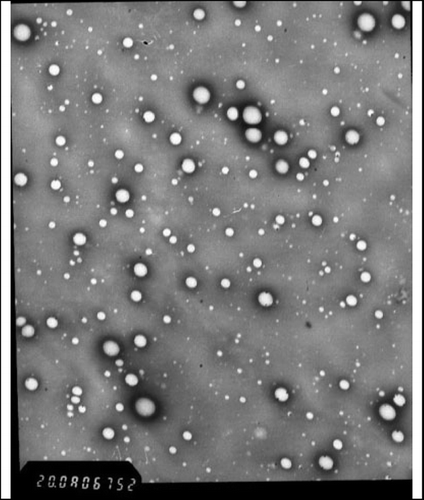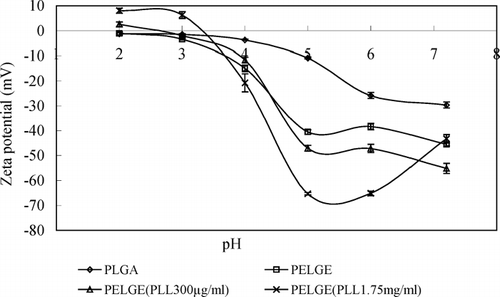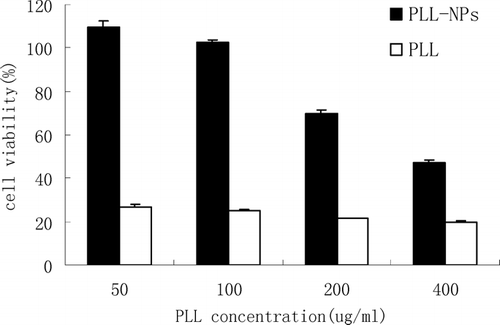Abstract
Plasmid(p) DNA was condensed by polycationic peptide polylysine (PLL) to be a core and then encapsulated in biodegradable monomethoxy (polyethyleneglycol)-poly(lactide-co-glycolide)-monomethoxy (poly-ethylene glycol) (PELGE) to form core-shell nanoparticles as a novel gene delivery system PPD (PELGE-PLL-DNA). Nanoparticles formed from PPD had several complementary properties such as improved biocompatibility, decreased cytotoxicity, enhanced pDNA integrity, and the characteristic of lysosomal escape as PLGA nanoparticles. The results demonstrated the potential of this PPD as an efficient gene delivery system.
Plasimd DNA (pDNA) has been shown to have great potential for gene replacement therapy, therapeutic application, and vaccines (Hedley, Curely, and Urban Citation1998). However, the use of pDNA-based pharmaceuticals as drug substances largely depends on the development of safe and efficient delivery systems. Nonviral vectors, including cationic liposomes, synthetic polymers, and particles, are attractive because they are associated with fewer safety concerns and are easier to produce.
Among nonviral vectors, nanoparticles and microparticles formulated using poly (D.L-lactide-co-glycolide) (PLGA) and polylacide (PLA) polymers are being investigated because of their sustained-release properties, biocompatibility, biodegradability, and their ability to protect pDNA from degradation(Swayam and Vinod Citation2004). In addition, Jayanth et al. (Citation2002) have reported the observed unique rapid (< 10 min) endolysosomal escape of biodegradable nanoparticles formulated from the copolymers of poly (DL-lactide-co-glycolide) (PLGA). However, hydrophobicity and acidic microenvironment during degradation (Walter et al. Citation1999; Penco et al. Citation1996) of PLA and PLGA limit their further utility. Introduction of polyethylene glycol (PEG) has improved hydrophilicity (Liu and Deng Citation2002; Perez et al. Citation2001), but the problem of an acidic situation still remains.
Polylysine was one of the earlier polypeptides used as a gene carrier for its excellent DNA condensation property and efficient protection of DNA from the attack of nucleases (Capan et al. Citation1999). Furthermore, it can improve transfection efficiency due to its positive charge (Son et al. Citation2000). Unfortunately, one of the serious limitations of cationic polymers as transfection agents is their detrimental influence on cell viability. The transfection effieiency is closely related to the cytotoxicity of the cationic polymers (Fischer et al. Citation1999). To reduce its cytotoxicity and to improve transfection efficiency, PLL has been modified by conjugating with PEG (Choi et al. Citation1998), histidine, and targeting ligands including polysccharides, tansferrin, and galactose.
The combined use of polycationic peptide and biodegradable macromolecular polymer in gene delivery system is known. PLGA microspheres containing PLL-pDNA were formulated by Yilmaz Capan (Capan et al. Citation1999) and PLGA-grafted PLL (PLL-g-PLGA) micelles were produced by Ji Hoon Jeong (Jeong and Gwau Citation2002). But few reports have focused on the nanoparticles and complementary merit of this combination, such as improved biocompatability of copolymer, decreased cytotoxicity, resistance of acid and sonication, and the characteristic of lysosomal escape as PLGA nanoparticles.
We have synthesized mPEG-PLGA-mPEG tri-block copolymers (PELGE) (Sun et al. Citation2005), and in our present study, we prepared PLL-pDNA complex-loaded PELGE nanoparticles (NPs) to investigate the merits of this novel delivery system. It is promising to solve some previous problems existed, such as poor biocompatibility, cytotoxicity, DNA degradation, and obstacle of lysosomal escape, compared with PLGA nanoparticles and PLL-pDNA (PD) complex.
MATERIALS AND METHODS
PLGA (Mw8000–10000) was supplied by Shandong Institute of Medical Instrument (China); PELGE was prepared as described in the literature (Sun et al. Citation2005) (Mw10, 000, determined by GPC). Poly (L-lysine)-hydrobromide (Mw 25,000) was purchased from Sigma (St. Louis, MO, USA) and polyvinyl alcohol (88% hydrolyzed, Mw 22,000) from Acros Organics (USA). The plasmid pORF lacZ (3.54kb) was purchased from Invivogen (USA), Qiagen Giga Endo-free plasmid purification kit from Qiagen (CA, USA). All the other chemicals and reagents used were of analytical grade obtained commercially.
Preparation of Nanoparticles
pORF-lacZ plasmid DNA was isolated and purified from DH5-E. coli using the Qiagen Giga Endo-free plasmid purification kit. PLGA-NPs and PELGE-NPs were prepared by a traditional double emulsification-solvent evaporation technique (He et al. Citation2004) with slight modification.
In brief, PLL-pDNA complex (PD, pDNA:PLL ratio = 1:1, w/w) was prepared by gentle mixing of 50 μ l pDNA (500 μ g/ml) in Tris-EDTA buffer (10 mmol/L Tris-HCl buffer containing 1 mmol/L EDTA, pH7.4) with 50 μ l of PLL(500μ g/ml) in the same buffer, following incubation at room temperature for 30 min. Then 10 mg PLGA or PELGE was dissolved in 1 ml dichloromethylene and 100 μ l PD were added and emulsified by sonication for 20 sec to obtain the primary emulsion. Then, 2ml polyvinyl alcohol (PVA) solution (0.5%, w/v, if not mentioned specifically) was added to this emulsion. The w/o/w emulsion was obtained by another 20sec-sonication and then pored into 8 ml of the same PVA solution, magnetic stirring for 4 hr at room temperature to allow solidification of the nanodroplets and elimination of the organic solvents. The nanoparticles were finally collected by centrifugation at 40 000 ×g for 60 min at 4°C. The sediments were rinsed twice to remove PVA and unentrapped DNA, resuspended in sterile water, and lyophilized.
Physical and Chemical Characteristic of NPs
Particle Size and Morphology
Particle size was measured by both photon correlation spectroscopy (PCS) (Zetasizer Nano ZS90, Malvern Instruments Ltd., UK) with a 50 mV laser and transmission electron microscope (TEM). Then 1 mg of nanoparticles was diluted by 2 ml of 10 mM Hepes buffer and added into the sample cell. The measurement time was set at 2 min (rapid measurement) and each run consisted of 10 subruns. The size distribution follows a lognormal distribution.
For TEM inspection, negative staining electron micrographs of nanoparticles were taken using a JEM-100SX electron microscope. A sample of NPs was directly examined under the transmission microscope.
Zeta Potential Measurements
Surface charges of PELGE, PLGA nanoparticles, and PD complex, suspended in gradual changed pH Hepes buffer (pH2-pH7) and diluted serum (10%), were determined by zeta potential measurement on a Malvern Zetasizer Nano ZS90 with a mode described before. Measurements of the zeta potential were carried out at 1 pH increments at 25°. The zeta potential was measured at least three times at appropriate concentrations of samples.
Cell Cytotoxicity
L929 cells were cultured in 96-well microtiter plates at a density of 2× 103 cells/well in 100 μ l cf growth medium consisting of 1640 with 10% FBS and antibiotics. Cells were grown at 37° for attachment. The culture medium was replaced with PBS containing the desired amount of sterile PLL and PLL-loaded PELGE NPs. After incubation of 6 hr, these PBS were removed and fresh growth medium was added for an additional 48 hr. Cell viability was evaluated by relative growth ratio (RGR) using MTT assay, with a Bio-Rad 500 spectrophotometric microplate reader. The PBS buffer was tested as negative control. The RGR of sample was calculated as follows.
Stability Against Sonication and Acidic Microenviroment
First, 100 μ l pDNA and PD (500 μ g/ml) complex (PLL/pDNA = 1) in 10 mmol/L TE were prepared as interwater phase of primary emulsion as described before, respectively. The sonication was performed using a probe sonication at an energy level of 40W for 0, 20, 40, 60, 100, and 140 sec in ice bath. After formation of primary emulsion, samples were centrifugated at 20 000× g for 10 min at 4° without solidification, and pDNA in water phase was sampled 10 μl per time.
To study the stability against acidic microenviroment induced by PELGE degradation, 100 μ l pDNA and PD were diluted by pH2, 3, 4, 5, 6, 7 Hepes and incubated at 37° for 1, 12, 36, and 72 hr.
Both sonicated and low pH incubated pDNA samples were analyzed by gel electrophoresis on a 0.8% agarose gel prepared in TAE buffer (pH8.0, 40 mmol/L Tris-acetate, 2 mmol/L EDTA) containing 0.5 mg/ml ethidium bromide. Prior to electrophoresis, PD complex was dissociated by the addition of heparin (Sun, Zhang, and Zhang Citation2004), to release pDNA from the condensate. pDNA combined with loading buffer was then loaded onto the gel and electrophoresed for 1.5 hr at 90V. DNA bands were visualized under ultraviolet light after ethidiun bromide staining.
RESULTS AND DISCUSSION
Particle Size and Morphology
PELGE-PLL-pDNA nanoparticle formed here, with PELGE as the shell and PLL/DNA as the core, is schematic represented in . According to the micrographs (), nanoparticles using PELGE as material (with 0.5% PVA as emulsifier) were spherical in shape and almost uniform with the average particle size about 250 nm. For PCS, the average particle size was expressed as the intensity mean diameter (nm) with PDI (poly dispersity index) less than 0.2. Changes in PVA concentration significantly influenced the particle size. As shown in , with the same concentration of PVA in the continuous phase, PLGA-NPs (303.26 ± 4.72 nm) were bigger than PELGE-NPs (244.35 ± 2.90 nm), owning to the hydrophobic group and the hydrophilic group of the copolymers that provide the emulsification capability (Walter et al. Citation1999). The phenomenon that the particle size of PELGE-NPs decreased (from 436.40 ± 2.97 to 244.35 ± 2.90 nm) as the PVA concentration decreased (from 2% to 0.5%), and then increased (from 244.35 ± 2.90 to 308.7 ± 5.58 nm) as the PVA concentration continuously decreased (from 0.5% to 0.1%), may be attributed to the balance between emulsification and ultrasonic stress force. When PVA concentration stays at a high level (2%) with high viscosity (Capan et al. Citation1999), the stress force of sonication may not be efficient for emulsification, whereas with continuing decrease to 0.1%, the emulsification using PVA as a stabilizer is inefficient.
PVA is a commonly used emulsifier in the formulation of nanoparticles, mainly because the nanoparticles are smaller and more uniform in size and are easier to redisperse in buffer or saline (Swayam et al. Citation2002). But residual PVA associated with the reduced gene transfection (Jayanth et al. 2004) since it can increase the surface hydrophilicity of NPs (Sahoo et al. Citation2002). Moreover, PVA was not allowed by the U.S. FDA even for surgical use. In terms of PEG in this novel constructed system, it not only increases the hydrophilicity of the NPs, and decreases the concentrate of PVA, but it also hits good biocompatibility.
FIG. 1 Schematic representation of the PELGE-PLL-pDNA nanoparticle were formed here, with PELGE as the shell and PLL/DNA as the core.
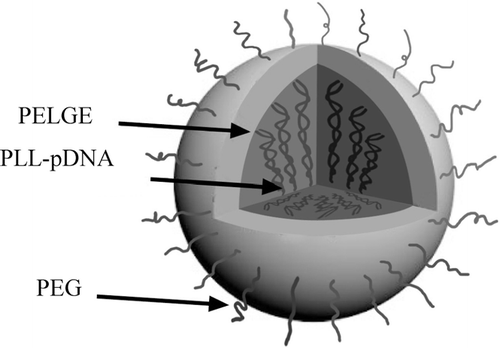
TABLE 1 Size of the nanoparticles formulated using different concentrations of polyvinyl alcohol (PVA) (n = 3)
Zeta Potential
The zeta potentials of different NP formulations in various pH Hepes buffer are shown in . It has been reported that PLA-PEG nanoparticles had higher zeta potential than PLA nanoparticles due to the presence of the PEG chains on the surface of NPs (Perez et al. Citation2001). In the present study, the zeta potential also was increased when PELGE triblock copolymers were used as the matrix in comparison with PLGA. In PLGA nanoparticles, both the lactic acid and glycolic acid segments contributed to the surface charge. However, in PELGE nanoparticles, the carboxyl groups of PLGA were condensed with the hydroxyl groups of the mPEG. As a result, the amount of free lactic acid and free glycolic acid segments decreased, which led to the enhanced zeta potential of the PELGE nanoparticles.
Furthermore, the mPEG on the surface of the PELGE nanoparticles could prevent the lactic acid and the glycolic acid from ionizing. The increasing zeta potential of the NPs may greatly affect their behavior in vivo. On the one hand, mPEG improved the stability of NPs in physiological conditions, but on the other hand, higher negative zeta potential might affect the cellular uptake. Fortunately, PLL may be a good adjuster for its amphoteric property. At low pH, it made PELGE-NPs take positive charges, at pH5–6 have the highest negative zeta potential, at pH 7.2 be the same as PLGA-NPs (, PELGE [PLL1.75 mg/ml)].
The endolysosomal escape of drug carriers is crucial to enhancing macromolecular payload, which is especially susceptible to lysosomal degradation. Jayanth et al. (Citation2002) have reported the biodegradable PLGA-NPs were characterized by rapid (< 10 min) endolysosomal escape by the mechanism of selective reversal of the surface charge of NPs (from anionic to cationic). They found that PLGA-NPs had negative charges in physiological and alkaline pH but acquired positive charges in the acidic pH that is presented in the endolysosomal vesicle (pH∼ 4), which might escape from endosomes by a mechanism similar to that operating for cationic lipids. To test whether PELGE-NPs remain this merit, we incubated NPs in Hepes buffer at different pH values. showes PELGE-NPs have a slightly bigger selective reversal of surface charge than PLGA, which were not as obvious as reported. But adding a certain amount of PLL in the primary emulsion, changes became significant. We demonstrated that PELGE at least retained the property of charge conversion of PLGA.
In the diluted serum, the stability of PELGE-NPs has obvious priority, which is the premise of intravenous use and long circulation of NPs. As shown in (mean ± SD, n = 3), PLGE-NPs had much higher zeta potential (−29.38 ± 1.21mV) than PLGA-NPs (−17.17 ± 1.16mV). PEG has been extensively used in biomedical applications due to its excellent ability to reduce protein adsorption on the PEG-modified surface and superior biocompatibility and toxicity. This phenomenon can be explained by previously published work (J. Hoon et al. Citation2000), that demonstrated PEG could reduce protein adsorption onto polymer surfaces, such as human gamma globulin, presented in high concentration in blood.
TABLE 2 Zeta potential of PLGA and PELGE NPs, in 10% serum
Cell Cytotoxicity
Some studies showed that cytotoxicity was originated from the structural destabilization of lipid membranes by polycations, but the process of cationic polymer-mediated cytotoxicity is still unclear. The comparative effects of PLL-loaded PELGE NPs and PLL on cell viability were determined by a MTT assay, as shown in . Compared with PLL, of which RGR was always less than 30%, the PELGE-PLL NPs showed at least twice lower cytotoxicity. The decrease of cytotoxicity for NPs was due to the charge conversion from positive to negative in physiological conditions. When complexed with DNA, the PLL-pDNA might form a ‘spaghetti and meat ball’ structure to minimize the direct contact of polycations to cell membrane. The low cytotoxicity of these polycationic and biodegradable nanoparticle vectors, having an unhampered superior DNA condensation capacity, may be beneficial for both large dose and repeated administration of gene.
Stability Against Sonication and Acidic Microenvironment
Ultrasonic radiation can convert supercoiled DNA to linear and open circular forms, during preparation of nanoparticles, resulting in significant reduction in gene expression (R. Adami et al. Citation1998). But previous studies (Capan et al. Citation1999; Adami et al. Citation1998) on the protection ability of PLL under sonication conditions had contrary data. To better distinguish the relative differences in pDNA, degradation following sonication of naked pDNA and pDNA/PLL (1:1) complex was analyzed by gel electrophoresis ( and ). They were challenged with 40 W sonication for up to 140 sec. Sonication of naked pDNA resulted in extensive fragmentation within 60 sec (, lane 4), while complexed pDNA remain integral for 100 sec (, lane 5).
According to our results, PLL can really protect pDNA from being damaged in sonication, but its ability is limited due to the intensity of sonication and the kind of polylysine used (Adami et al. Citation1998). At least, PD is stable during our preparation (40w, 40s).
FIG. 5 Stability of peptide/DNA condensates in ultrasonication and acidic microenvironment. (A) pDNA suffered from ultrasonication for 0, 20, 40, 60, 100, and 140 sec (lanes 1 to 6). (B) pDNA/PLL (1:1 w/w) suffered from ultrasonication for 0, 20, 40, 60, 100, and 140 sec (lanes 1 to 5) and then released by heparin. (C–F) pDNA/PLL (1:1 w/w, lane 1 to 5) and pDNA (lane 6 to 10), were subjected to pH 2 to pH 6 for 1, 12, 36, and 72 hr, relative to standard DNA (lane11).
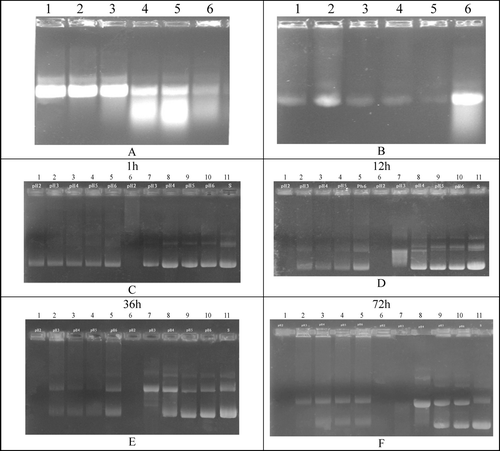
The degradation of PLGA and PEG segments will produce acidic agents (Penco et al. Citation1996) and it has been reported before that double-stranded DNA is rapidly degraded under acidic conditions (Walter et al. Citation1999). , , showed PLL could protect pDNA from acidic microenvironment. For incubation at pH2, pDNA in PLL/DNA remained intact ( lane 1) while free pDNA changed to linear and open circular or failed to migrate within 1 hr ( and lane 6). Similar results were obtained at pH3 (, , , lane 2 and 7), which may be due to the amphoteric property of polylysine. The residual amido of PLL can seize H+ to prevent DNA from its attack (Penco et al. Citation1996).
CONCLUSION
In our research, a novel gene delivery carrier composed of PELGE, PLL, and pDNA (PPD) has been constructed. PLL was introduced to condense negative charged pDNA, and PD-loaded PELGE nanoparticles were prepared by a double emulsification method. The effects of monomethoxypoly (ethyleneglycol) (mPEG) segments and polylysine in the polymer on particle size, zeta potential, DNA integrity, and their merit for escaping from lysosome were investigated. We found that the introduction of hydrophilic mPEG segments in the copolymer chains could improve the biocompatibility of copolymer and still maintain the property for lysosomal escape. Also PLL protected DNA from being destroyed in ultrasonic and acidic microenvironments during formulation and degradation. Thus DNA-loaded nanoparticles with smaller particle size, better protecting property, and escaping character were obtained by combined use of PPD as a new gene delivery system.
This research was performed with support from the National High Research and Development Program of China (863 program) via grant 2004AA27-133142.
REFERENCES
- Adami Roger C., Collard Wendy T., Gupta Shamita A., et al. Stability of peptide-condensed plasmid DNA formulations. J. Pharmaceut. Sci. 1998; 87: 678–683, [CSA]
- Capan Y., Woo B. H., Gebrekidan S., et al. Influence of formulation parameters on the characteristics of poly (d,l-lactide-co-glycolide) microspheres containing poly(l-lysine) complexed plasmid DNA. J. Control. Rel. 1999; 60: 279–286, [CSA], [CROSSREF]
- Capan Y., Woo B. H., Gebrekidan S., et al. Stability of poly (L-lysine)-complexed plasmid DNA during mechanical stress and DNase I treatment. Pharmaceut. Dev. Technol. 1999; 4: 491–498, [CSA], [CROSSREF]
- Choi Y. H., Liu F., Park J. S., Kim S. W. Lactose-poly(ethylene glycol)-grafted poly-L-lysine as hepatoma cell-tapgeted gene carrier. Bioconjug. Chem. 1998; 9: 708–718, [INFOTRIEVE], [CSA], [CROSSREF]
- Fischer D., Bieber T., Li Y., et al. A novel non-viral vector for DNA delivery based on low molecular weight, branched polyethylenimine: effect of molecular weight on transfection efficiency and cytotoxicity. Pharm. Res. 1999; 16: 1273–1279, [INFOTRIEVE], [CSA], [CROSSREF]
- He Q., Liu J., Sun X., Zhang Z. R. Preparation and characteristics of DNA-nanoparticles targeting to hepatocarcinoma cells. World J. Gastroenterol. 2004; 10: 660–663, [INFOTRIEVE], [CSA]
- Hedley M. L., Curely J., Urban T. Microspheres containing plasmid-encoded antigens elicit cytotoxic T-cell response. Nature Med. 1998; 4: 365, [INFOTRIEVE], [CSA], [CROSSREF]
- Liu Y., Deng X. M. Influences of preparation conditions on particle size and DNA-loading efficiency for poly(dl-lactic acid–polyethylene glycol) microspheres entrapping free DNA. J. Control. Rel. 2002; 83: 147–155, [CSA], [CROSSREF]
- Jayanth P., Zhou W. Z., Swayam P., et al. Rapid endo-lysosomal escape of poly (DL-lactide-co-glycolide) nanoparticles: implications for drug and gene delivery. FASEB J. 2002; 16: 1217–1226, [CSA], [CROSSREF]
- Jeong Ji Hoon, Woo Lim Dong, Keun Han Dong, Gwan Park Tae. Synthesis, characterization and protein adsorption behaviors of PLGA/PEG di-block co-polymer blend films. Colloids Surfaces B: Biointerface 2000; 18: 371–379, [CSA], [CROSSREF]
- Jeong Ji Hoon, Park Tae. Poly (l-lysine)-g-poly (d,l-lactic-co-glycolic acid) micelles for low cytotoxic biodegradable gene delivery carriers. J. Control. Rel. 2002; 82: 159–166, [CSA], [CROSSREF]
- Penco M., Silvia M., Ferruti P., et al. Degradation behaviour of block copolymers containing poly(lactic-glycolic acid) and poly(ethylene glycol) segments. Biomaterials 1996; 17: 1583–1590, [INFOTRIEVE], [CSA], [CROSSREF]
- Perez C., Sanchez A., Putnam D., et al. Poly(lactic acid)-poly(ethylene glycol) nanoparticles as new carriers for the delivery of plasmid DNA. J. Control. Rel. 2001; 75: 211–224, [CSA], [CROSSREF]
- Sahoo Sanjeeb K., Jayanth P., Swayam P., Vinod L. Residual polyvinyl alcohol associated with poly (d,l-lactide-co-glycolide) nanoparticles affects their physical properties and cellular uptake. J. Control. Rel. 2002; 82: 105–114, [CSA], [CROSSREF]
- Son Kyonghee K., Tkach Diane, Patel Dhaval H. Zeta potential of transfection complexes formed in serum-free medium can predict in vitro gene transfer efficiency of transfection reagent. Biochim. Biophys. Acta 2000; 1468: 11–14, [INFOTRIEVE], [CSA], [CROSSREF]
- Sun X., Duan Y. R., He Q., et al. PELGE nanoparticles as new carriers for the delivery of plasmid DNA. Chem. Pharm. Bull. 2005; 53: 599–603, [INFOTRIEVE], [CSA], [CROSSREF]
- Sun X., Zhang H. W., Zhang Z. R. Transfection efficiency of pORF lacZ plasmid lipopolyplex to hepatocytes and hepatoma cells. World J. Gastroenterol. 2004; 10: 531–534, [INFOTRIEVE], [CSA]
- Swayam P., Zhou W. Z., Jayanth P., Vinod L. Size-dependency of nanoparticle-mediated gene transfection: studies with fractionated nanoparticles. Int. J. Pharm. 2002; 244: 105–115, [CSA], [CROSSREF]
- Swayam P., Vinod L. Critical determinants in PLGA/PLA nanoparticle- mediated gene expression. Pharm. Res. 2004; 21: 354–364, [CSA], [CROSSREF]
- Walter E., Karin M., Pavlovic J., Merkle H. P. Microencapsulation of DNA using poly(dl-lactide-co-glycolide): stability issues and release characteristics. J. Control. Release. 1999; 61: 361–374, [INFOTRIEVE], [CSA], [CROSSREF]

